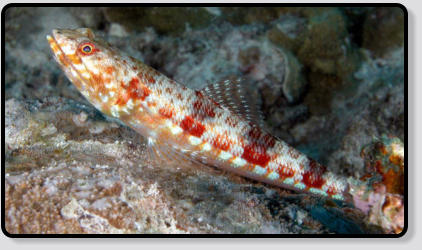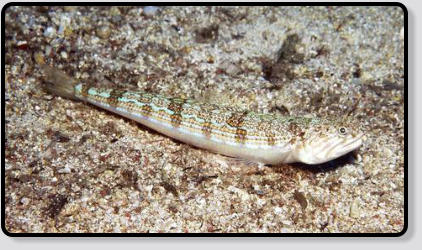Scientific classification
Kingdom:
Phylum:
Chordata
Class:
Actinopterygii
Order:
Aulopiformes
Family:
Synodontidae
Genus:
Synodus
Species:
S. Synodus
Binomial name (link Wikipedia)




Diamond Lizardfish
Poisson Lézard
Eidechsenfisch
Lagarto
Diamant Hagedisvis

Description
Length: up to 40 cm.
Habitat: Rocky and sandy bottoms.
The diamond lizardfish is recorded to be found within a marine environment within a reef-associated area. This species lives generally in the
depth range of 2 – 35 meters. They are native to the subtropical climate. The maximum recorded length of the diamond lizardfish as an unsexed
male was about 33 centimeters or about 1.08 feet long. The common length of this species is about 20 centimeters or 7.87 inches. This species
is commonly identified by the dark red stripes on its back. The diamond lizardfish is distributed and occupies the areas of Eastern Atlantic,
Madeira, canary Islands, St. Helena Island, São Tomé Island, Western Atlantic, Florida, United States of America, southwestern Gulf of Mexico,
Uruguay, Caribbean, Northwest Atlantic, and Canada. It is common to find the diamond lizardfish in shallow inshore waters. This species is
known to prefer to stay on hard surfaces rather than sandy bottoms. It also can be found in reef areas and it also goes into open shelf water as
deep as 90 meters. This species can be eaten and has been recorded to taste relatively good, but it is not commonly eaten. The diamond
lizardfish is occasionally caught with artisanal gear used by humans. This species serves as no threat and to humans and it is harmless. This
species cannot be kept in an aquarium or traded for commercial usage.

Animalia
Scientific classification
Kingdom:
Phylum:
Chordata
Class:
Actinopterygii
Order:
Aulopiformes
Family:
Synodontidae
Genus:
Synodus
Species:
S. Saurus
Binomial name (link Wikipedia)




Atlantic Lizardfish
Poisson Lézard
Eidechsenfisch
Lagarto
Atlantische Hagedisvis

Description
Length: up to 40 cm.
Habitat: Rocky and sandy bottoms.
The Atlantic lizardfish is known to be found in a marine environment within a general demersal depth range of about 400 meters. They are more
specifically found in a depth range of about 20 meters. This species is native to a subtropical climate. The maximum recorded length of the
Atlantic lizardfish as an unsexed male is about 40 centimeters or about 15.74 inches. The distribution of this species occupies the areas of
Eastern Atlantic, Morocco, Cape Verde, Azores, Mediterranean, Western Atlantic, Bermuda, Bahamas, Lesser Antilles, and the Leeward Islands.
This species is mainly known to be found in insular waters and on top of sandy or sand-rock bottoms. The diet of the Atlantic lizardfish mainly
includes other species of fish, but it is known to also feed occasionally on other animals. The Atlantic lizardfish can be found occupying waters
around islands. The Atlantic lizardfish keeps itself hidden and camouflaged by burrowing itself in the sand. While it is burrowed in the sand, this
species reveals his eyes so that it can watch its prey and pounce when food is available.
Animalia

Harry van Goor 2016
source: Wikipedia, the free encyclopedia


Categories: Lizardfish

